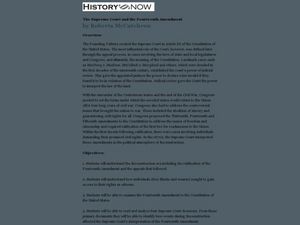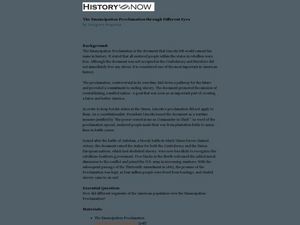Curated OER
Rights and Responsibilities, Is It Breaking the Law?
Students investigate the life and trial of Rev. John Mahan who was involved with the illegal Underground Railroad. The issue of breaking the law to help slaves escape is examined in this lesson.
Curated OER
Trial of John Brown, 1857
Students examine how John Brown's 1857 trial related to conflicting viewpoints on slavery, view perspectives of radical abolitionists, moderate abolitionists, and slave owners, and form their own opinions on issue of slavery.
Curated OER
Road to War Assessment
In this American Civil War worksheet, students respond to 20 short answer, multiple choice, and true or false questions about the events that led to the outbreak of war.
Curated OER
Structured Academic Controversy (SAC) in the History Classroom
SAC is a specific approach to discussing history and controversial issues. Rather than adhering to an either/or debate-style paradigm, it fosters speaking and constructivist listening to enable learners to build consensus through...
Curated OER
How We Got to Kansas-Nebraska
Learners explore the causes of the Civil War. In this lesson on slavery students use primary sources to examine the evolution of the issue of slavery and in the American political system. Learners will then write a follow-up essay that...
Curated OER
The Constitution
Eighth graders conduct research about the weaknesses of the Articles of Confederation, the Virginia Plan, the New Jersey Plan, the Connecticut (Great) Compromise, and the 3/5 Compromise.
Curated OER
Popular Sovereignty and the Lecompton Constitution
Students review the Kansas-Nebraska Act and the development of the Kansas territory Constitution. They complete a cause and effect worksheet and discuss the history of the Lecompton Constitution.
Curated OER
California's First Constitution
Students read excerpts from speeches made at the California Constitutional Convention. They predict what the state constitution say about slavery and other issues concerning race.
Curated OER
Fugitive from Labor Cases:
High schoolers examine the cases of Henry Garnett and Moses Honner, both of the 1850s. Students analyze the political climate building up to the Civil War through the lens of these similar cases with different outcomes.
Curated OER
The 1808 Slave Trade Abolition Deadline
Students study the trans-Atlantic Slave trade. In this slave trade activity, students study the Constitutional Convention Notes and the impact on United States slavery. Students research the slave trade database and other primary sources...
University of California
The Civil War: The Road to War
The United States Civil War resulted in the highest mortality rate for Americans since the nation's inception. Delve deeper into the causes for the drastic separation of states with a history lesson plan that features analysis charts,...
Federal Judicial Center
Amistad and Dred Scott—a Comparative Activity
What do slaves fighting for their freedom on board a ship and a slave fighting for his freedom in a courtroom have in common? Budding historians investigate the two different cases of the Amistad slave revolt and the Dred Scott argument....
Curated OER
Black Kentuckians and the Civil War
Students demonstrate how the American Civil War affected black Kentuckians socially and politically. They identify and discuss the 13th Amendment to the U.S. Constitution, which forced the end of slavery in Kentucky months after the...
Curated OER
A Look at Virginians During Reconstruction
Fourth graders examine slavery and Reconstruction in Virginia. In this Virginians during Reconstruction instructional activity, 4th graders research primary sources for the story of William Jasper and other slaves. Students hypothesize...
Curated OER
American Civil War Lesson Plans
Civil War lesson plans can get students thinking about, and discussing issues related to history, politics, and even photography.
Alabama Department of Archives and History
Runaway Slaves in Alabama: Individual Freedom Fighters in the 1800s
Class pairs examine eight runaway slave advertisements from the mid-1800s to develop an understanding of the conditions slaves faced and of race relations.
Curated OER
The Supreme Court and the Fourteenth Amendment
Students examine the ratification of the Fourteenth Amendment. For this Reconstruction Era lesson, students read and analyze 4 Supreme Court decisions regarding the Fourteenth Amendment and determine how the decisions impacted citizen...
Curated OER
Fugitive from Labor Cases: Henry Garnett (1850) and Moses Honner (1860)
Students engage in the comparison of cases which demonstrate the increasingly volatile political crisis in the 1850s arising over the issue of slavery and the necessity for the enactment of the 13th, 14th, and 15th Amendments to the U.S....
Curated OER
The Civil War: Differences That Divided The Nations
In this Civil War worksheet, students complete a graphic organizer, filling in information showing the differences between the north and south with regards to slavery, culture, economy and The Constitution.
Curated OER
Racial Inequality: Remnants of a Troubled Time
Eighth graders study the ratification of the 14th Amendment and the Plessy v. Ferguson decision. In this US History activity, 8th graders read excerpts from the Brown v. Board of education decision. Students investigate one of three...
Curated OER
Inspiring Freedom: The Remond Family and Abolitionism in Salem
Students examine the abolitionist movement in Salem. Exploring the contributions of the Remond family, they identify how they made the issue one of national and international importance. They discuss the views of the south and how...
Curated OER
The Union is Perpetual: Lincoln is Elected
Middle schoolers view primary documents about the race for President in the time of Abraham Lincoln. For this election lesson, students prepare arguments for and against Lincoln using an analysis sheet. Middle schoolers create a poster...
Curated OER
A Lesson To Accompany "The First Bank of the United States: A Chapter in the History of Central Banking"
Here is an interesting topic. Learners examine the economics that led to the founding of the First Bank of America. They participate in a reader's theater experience depicting the debate between Alexander Hamilton and Thomas Jefferson...
Curated OER
The Emancipation Proclamation Through Different Eyes
Students examine how various segments of the American population viewed the Emancipation Proclamation. They read the Emancipation Proclamation, analyze key terms and statements in the document, and participate in a debate.

























